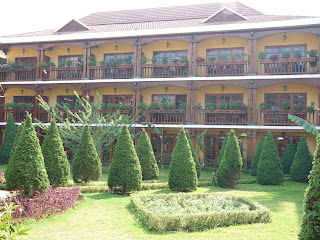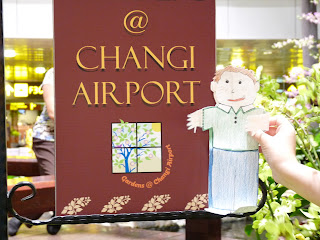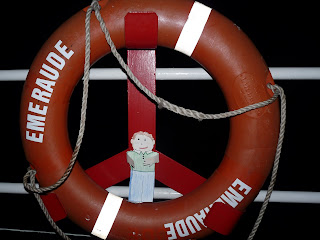
On January 25 we left for a short vacation to Bali, Indonesia. Bali is an Indonesia island which is strongly influenced by Indian and Chinese culture. The island is inhabited with a population of 3,151,000 people. The majority of Bali's population are Hindu whereas Indonesia as whole follows Islam. Tourism is the leading industry making it one of Indonesians wealthiest regions. The island is known for its arts - batik and ikat cloth, wood carvings, stone carvings , painting and music. While tourism is the money maker, agriculture is the largest employer in the region with the rice being the biggest industry. There is also coffee production , small amounts of fruits and vegetables and fishing.
Being there for only a short period we tried to balance fun with seeing the sights. The first full day we went white water rafting. We donned our gear, life vests, helmets and oars and set out for an 2 hour ride along the Telaga Waja River with our guide. We quickly learned the appropriate lingo and got the hang of going through the rapids after a few episodes of being hung up on the rocks! Our guide was quite the comedian constantly stopping short and flying us about in the boat. We ended our ride with a lunch on the river. Upon leaving the area we were bombarded with people trying to sell us goods. The goods ranged from small wood carvings to t-shirts and the people were relentless. Jim bought one t-shirt only to be pegged as someone who would buy and was immediately followed and almost harassed by another peddler. She followed him up 200 steps in an attempt to get him to purchase another t-shirt. She kept coming down in the price as he told her had no more money. If you can picture her walking up the steps, speaking Balinese/English chasing him down while carrying 20-30 more tshirts on her head, it was quite a sight!!
That evening we went to dinner at a fantastic restaurant with our friends, the Bartons. It was about an hour car ride away as everything in Bali is fairly spread out. The restaurant was on a plateau overlooking the ocean and rice fields. We arrived in time to catch a beautiful Balinese sunset and once set it started to rain so we ate in a semi covered area and had a meal of fresh fish. There was a local band there serenading all the tables. It was as if they were imitating the Beatles - it was really fun! After dinner, the rain stopped and we had a drink while listening to water crash upon the shore.
The next day we had a day of site seeing planned. We piled the kids - Allison, Kristin, Noah and George - and 4 adults - Jim, Jeff, Susan and myself with a driver, who charged $35 for the day , into a SUV and off we went. He first took us to the Batik making center. Batik is a traditional style of weaving, using a loom and hand dyed fabrics. Their were woman set up with their looms as well as women doing hand painted pictures on fabric using hot wax. Batik pieces are passed down through family generations. There are certain tribes that know that art of Batik making, and generally the girls start learning the process around the age of 13. What is produced ranges from simple shirts, dresses, boxes to large framed pieces. It is quite an industry for the people creating them. We next went to a silver shop where they make jewelry. Most of the silver and gold is imported by they do all the art work. As with any industry in Bali, the sales people follow you around the store and if you show the slightest bit of interest the bargaining begins. You have to be able to walk away if you want to bargain them down otherwise they are full of reasons why the price is firm. Bargaining is definitely an art that you get better at with experience.
We next went to lunch at a beautiful restaurant that overlooked rice fields. The rice fields are absolutely beautiful and I have whole new respect for every grain of rice I eat! It is an enormous amount of work and the individuals harvesting the rice are all ages. There quite a few older men and women in the fields in the heat picking the rice. We then all piled back into the car and headed out for the wood carving store.
Wood carving is a speciality in Bali. The store has magnificent pieces, some enormous and some as simple as a recorder. At the front entrance the artist were there carving the wood and it is really quite a process. It was amazing to watch them work the wood and see the end results of what could be created. The compound where the store was housed family homes as well. There was a temple in the middle that was quite a site - large golden figurines. Obviously this was a well to do family who had more solid structures than the home we had previously viewed. The artwork was amazing and we walked away with a piece that depicted the Indonesian version of Romeo and Juliet. In their version the ending is a happy one and they end up together!
Our guide then took us to a typical Balinese home. Individuals let tourist see their homes as a way to get money. When entered into an open space or large compound area that housed about 4 huts. Two huts were sleeping quarters, another a kitchen , one was an open bed that was used only when someone passed away and displayed the body. Each hut was raised off the ground and had thatched roofing which is said to last about 30 years. The kitchen was very basic with no refrigeration, no electricity. The woman start cooking in the morning on a wood burning stove and food is kept for 48 hours and then discarded. Each compound has its own temple for which the family prays to the Gods and pays homage to its ancestors. The compound had a well for water, pigs, chickens and 2 porcupines which had been captured because it had been eating the rice in the fields and were housed and fed. They had certain chickens that were kept in cages for chicken fighting which is a ritual for them. There was no plumbing on the grounds. The compounds are passed down through generations and house members of the family as the family grows. Men stay at their compounds and women , upon marriage, move in with the men's family.
Our next stop of the day was an art gallery. It had local painters in the front of the shop creating art, drawing and painting. The art ranged in size and style. Some were still life paintings, others very modern depictions. the gallery went on and on in every direction. It was almost so overwhelming the number of painting that it was difficult to decide on what caught you eye. We picked up a painting for friends of our back in Singapore that they had seen in the works when they were last in Bali that was now completed. The artist was there working on another piece, it was fun to be able to see the artists at work.
Our final stop of the day was the Monkey Forest. Monkeys in Indonesia are considered to be sacred animals. The forest is an actual preservation site in which researchers are able to study the monkeys behavior within their habitat. That being said the monkeys are very attuned to the humans and that humans bring food and therefore are fairly forward in approaching humans. Jim, Allison and Kristin all had a monkey climb up on their shoulders and heads in order to get food! Once there, they were fairly comfortable and unfazed to be sitting on them! It is unbelievable how many monkeys there are - thousands! Big, small, young and old - could be the makings for a Dr. Seuss book! It was quite a site and the monkeys just roam around looking for any food you have to offer.
Our final day in Bali was a pool day at the resort. We really needed to build a little more of this into our stay as the sight seeing and the time spend in the car was tiring. The girls loved the pool and the pool bar was really fun!
Bali overall was a nice getaway. It was very different than I had envisioned as I think it is often painted as paradise. I found it to be an interesting place but not as tropical and breath taking as I would have thought. The people of Bali are kind and hard working. The standard of living is low compared to what we are accustom to and many jobs are very labor intensive. In my view it is a very hard life and the city is crowded with very narrow roads. It would not be uncommon to see a family (mother, father, child and baby) on one motorcycle as that it a major mode of transport. The transportation infrastructure is very archaic and the roads sometime have room for only one car even though there is traffic in both directions! It is an eye opener to see how the rest of the World lives!!




















































